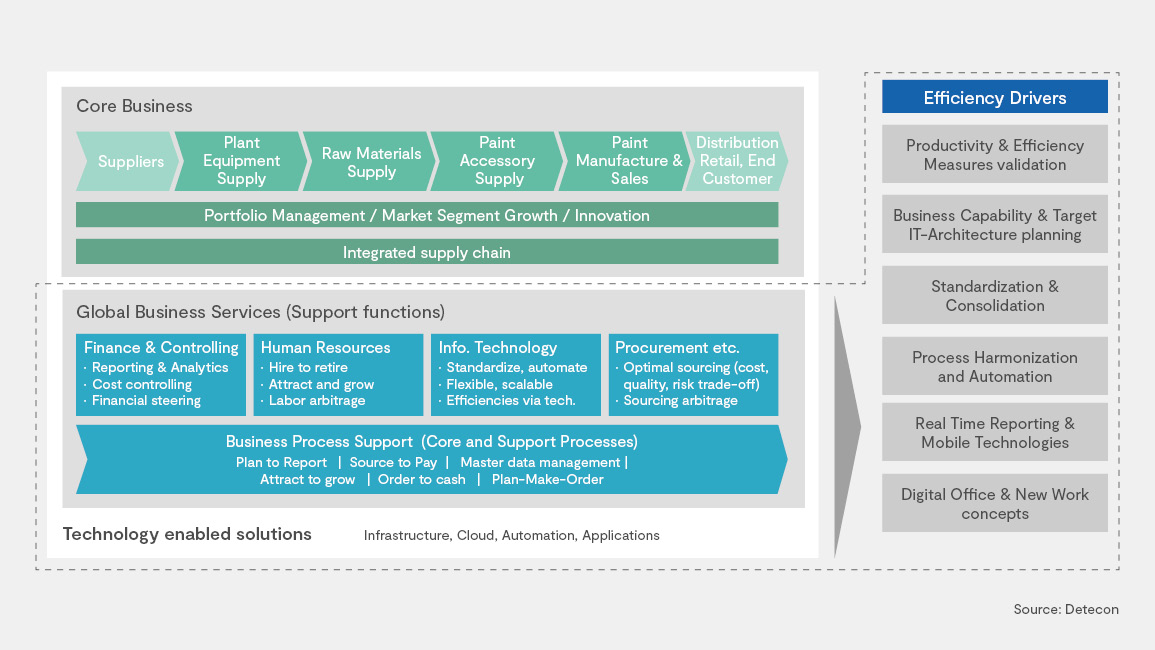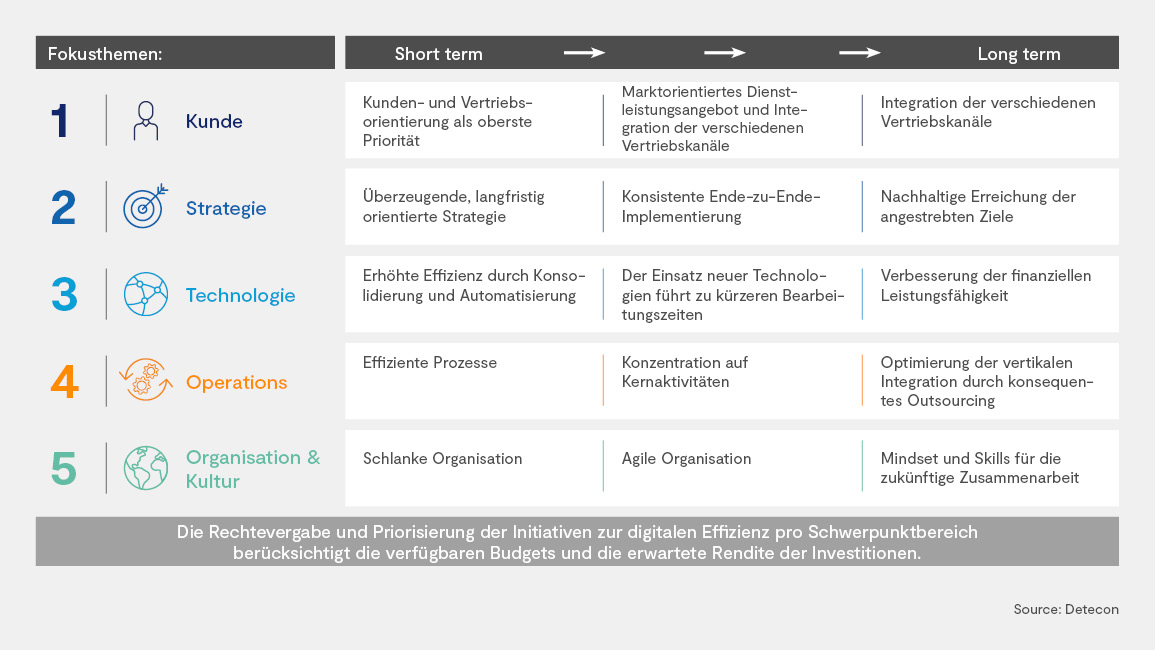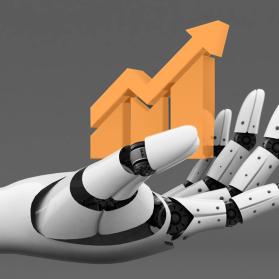Digitisation has emerged as a significant value driver and in many cases helps companies to better design processes and workflows. The focus is on being able to provide and process information always and everywhere. This information base promises to allow faster and better decisions to be made and thus to become more flexible, more efficient and simply more successful. However, digitalisation does not automatically mean increased efficiency. A digitisation measure can only be described as increasing efficiency if it simplifies process-related work steps, facilitates market access and is accompanied by a positive cost development compared to the investments made.
Digitisation primarily means transferring analogue processes into a digital version. Ideally, this step optimises and simplifies the process itself. However, this is not necessarily the case.
Process optimisation through digitalisation is not a foregone conclusion
Digital efficiency is the next necessary step in the digital transformation, which can be either
- completely integrated into the planned digital transformation and actively set the goal of optimising the digital processes compared to the analogue processes,
- as an independent initiative retrospectively attached to the ongoing or completed digital transformation, or
- in the sense of continuous improvement, iterative digital efficiency initiatives are carried out to evaluate the current status and take countermeasures.
The impact of Covid-19 has - by necessity - greatly accelerated digitalisation in many sectors and made the need for digital working methods inevitable. At the same time, this special situation has left few companies the time to plan this forced transformation in detail. This led to the fact that, for example
- individual systems were not fully integrated into the system landscape and work-arounds had to be used,
- digital collaboration tools have been introduced that overlap in their functionality or through further developments today. Examples of this can be found in collaboration software such as Teams, WebEx or Zoom for conferences and also in tools such as Miro, Mural, Conceptboard. But also cloud solutions such as Teams, Dropbox or iCloud are often used redundantly and drive up licence fees.
In this phase, CIOs and their teams have achieved great feats to secure operations. The CFOs' task is to review the sustainability of these measures in cooperation with the CIOs and to identify and implement optimisations by means of digital efficiency initiatives.
Digital Efficiency looks at the overall efficiency of a measure
Even if the effect of digitalisation was positive for the individual, from the company's point of view, this does not mean that a digitalisation measure was successfully implemented end-to-end.
Digital efficiency therefore always looks at the overall efficiency of a measure, which represents a process-related optimisation, brings about an improvement in the direction of the customer and has a positive cost effect on the company. For example, the best cloud-based software solution is of little use to a company if the costs for it get out of hand and reduce the long-term business success of a company.
Reasons for this are, for example, that a solution is not geared to the user or that the use of the solution by an unnecessary number of users drives up costs. In the age of rapidly changing and disruptive business models, the need to further increase the efficiency of digitalisation measures and achieve faster payback is becoming more prominent. Digital solutions themselves and their areas of application are increasingly changing and evolving, so that they may be replaced by new and better approaches.
Digitalisation is therefore both a blessing and a curse. There is no way around it, but there are still many hurdles and hidden traps in the long-term operation of digital solutions in an increasingly complex system landscape. Continuous re-evaluations of past and ongoing digital transformation measures as well as targeted efficiency planning for future measures are therefore essential for sustainable operation.
The Digital Efficiency Index and the Detecon Digital Efficiency Approach show how Detecon assesses the stage of digital efficiency, which challenges and trends we see in the various industries, but above all how we want to help companies to integrate the efficiency aspect into their transformation in concrete terms.
Digital Efficiency Index offers Benchmarking
With the Digital Efficiency Index, we assess the degree of digital efficiency in industries in the categories Customer, Strategy, Technology, Operations, Culture and Organisation on a five-level scale. The index is used to compare industries with each other and to demonstrate industry-specific strengths and deficits in certain categories. The scoring is based on a combination of three sources:
- Evaluation by industry experts who can draw on years of industry-specific project experience and are optimally networked with representatives from the industrial sectors.
- Collection of studies that examine the status quo and the plans of large companies and corporations with regard to their digital efficiency. The results provide the empirical basis for the Digital Efficiency Index.
- Extensive collection of data from project references including implemented measures and savings potentials to derive best practice approaches for improvement measures.
The scoring helps to create a better comparability between the industries and additionally makes it possible to rank individual companies within the respective industry in the course of a digital efficiency assessment.
The CXOs surveyed in the respective industries have some specific goals regarding efficiencies through digital methods. In each category, the following key themes emerged. The focus is on end-to-end implementations, which can be clustered into short-term and long-term goals.

Furthermore, the index gives an insight into digitalisation topics that are classified as main trends and challenges in the context of efficiency within an industry. With the help of this view, companies are given the opportunity to carry out a self-assessment and to question whether they have all areas in view in their own planning or, if necessary, adapt them or set other priorities.
Detecon Digital Efficiency Approach
Detecon has predefined a high number of efficiency measures and knows the value drivers of the individual measures. These are based on industry-specific experiences that have been successfully implemented in projects at clients. Combined with an empirical database, this is the starting point for the Detecon Digital Efficiency Approach.
Our approach consists of a two-stage process that starts with a Digital Efficiency Assessment and thus represents the individual ACTUAL situation. The assessment in turn consists of two main components, baselining and analysis, including target definition. In the course of baselining, in addition to a business capability analysis and a concrete problem analysis, mapping to the Digital Efficiency Index also takes place, so that an evaluation within the peer group of the same industry becomes visible. On the basis of the individual dimensions of the index, quick wins and particular pain points can be consolidated into a target.

The second phase of the Detecon Digital Efficiency Approach is more concretely concerned with future planning with the evaluation of measures, in which the most suitable initiatives are selected on the basis of use case journeys and specific business case considerations. In this phase, following the client's value chain, the most important efficiency drivers are identified and then further concretised.
In cooperation with our experts, long and short lists of suitable measures are provided for the customer. The initial transformation planning is then prepared for a selection of measures, so that a roadmap is provided to the CFO and his team, but above all tools for monitoring and safeguarding.
Inefficiency from digitalisation measures that have not been optimally implemented is not insignificantly reflected in the CFO's department, as processes slow down, resources are increasingly used and high CAPEX and OPEX expenses arise. With the help of a holistic approach, detailed transformation planning and a retrospective assessment with a clear focus on digital efficiency, measures can be successfully implemented and continuously improved to ensure sustainable business success.








